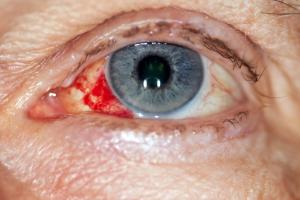
- #Blood vessel burst in eye skin
- #Blood vessel burst in eye Patch
If you look closely at the sclera you may just be able to see a few tiny blood vessels. In between the conjunctiva and the sclera run tiny blood vessels. It covers the white part of the eye (the sclera) but does not cover the central part of the eye (the cornea).
#Blood vessel burst in eye skin
The conjunctiva is like a thin skin on the front of the eyeball. The redness usually clears within two weeks. It can look alarming, but it usually causes no symptoms and is usually harmless. It is caused by a small bleed behind the conjunctiva. All rights reserved.A subconjunctival haemorrhage is one cause of a red eye. © 1998-2019 Mayo Foundation for Medical Education and Research (MFMER).
Do you have any symptoms associated with this?. What to expect from your doctorĮxamples of questions your doctor may ask, include: Do you have any brochures or other printed material that I can take home with me? Do you recommend that I visit a website related to this problem?ĭon't hesitate to also ask questions that occur to you during your appointment. Do I need to be referred to a specialist?. Are there any restrictions that I need to follow?. Are there any treatments for this condition?. For a subconjunctival hemorrhage, some basic questions to ask your doctor include: Preparing a list of questions may help you make the most of your time with your doctor. List all medications, vitamins and supplements that you're taking, including doses. List key personal information, including any major stresses or recent life changes. List any symptoms you're experiencing, including any that seem unrelated to the reason for which you scheduled the appointment. Here's some information to help you get ready for your appointment. In some cases when you call to set up an appointment, you may be referred immediately to an eye doctor (ophthalmologist). You're likely to start by seeing your primary care doctor. Beyond that, the blood will absorb within about 1 to 2 weeks, and you'll need no treatment. You may want to use eye drops, such as artificial tears, to soothe any scratchy feeling you may be experiencing. Obtain a routine blood test to make sure you don't have a potentially serious bleeding disorder. Ask you questions about your general health and symptoms. If you have recurrent subconjunctival hemorrhages, your doctor may also: Your doctor or eye doctor will generally diagnose a subconjunctival hemorrhage by looking at your eye. Rubbing too hard can cause minor trauma to your eyes, which may lead to a subconjunctival hemorrhage. If you need to rub your eyes, rub them gently. If the bleeding on the surface of your eye has a clearly identifiable cause, such as a bleeding disorder or blood-thinning medication, ask your doctor if you can take any steps to reduce the risk of a subconjunctival hemorrhage. If your condition is due to trauma, your doctor may evaluate your eye to ensure you don't have other eye complications or injury. Health complications from a subconjunctival hemorrhage are rare. 

Certain blood-thinning medications, such as warfarin (Coumadin, Jantoven) and aspirin.

Risk factors for a subconjunctival hemorrhage include:
Trauma, such as a foreign object injuring your eye. In some cases, a subconjunctival hemorrhage may result from an eye injury, including: The following actions may cause a small blood vessel to rupture in your eye: The cause of a subconjunctival hemorrhage isn't always known. If you have recurrent subconjunctival hemorrhages or other bleeding, talk to your doctor. Your only discomfort may be a scratchy feeling on the surface of the eye. #Blood vessel burst in eye Patch
The most obvious sign of a subconjunctival hemorrhage is a bright red patch on the white (sclera) of your eye.ĭespite its bloody appearance, a subconjunctival hemorrhage looks worse than it is and should cause no change in your vision, discharge or pain. A subconjunctival hemorrhage may look alarming, but it's usually a harmless condition that disappears within two weeks or so.Ī broken blood vessel in the eye may look alarming, but it's usually harmless. Even a strong sneeze or cough can cause a blood vessel to break in the eye. You may not even realize you have a subconjunctival hemorrhage until you look in the mirror and notice that the white part of your eye is bright red.Ī subconjunctival hemorrhage often occurs without any obvious harm to your eye. The conjunctiva can't absorb blood very quickly, so the blood gets trapped. In many ways, it's just like having a bruise on your skin. Last updated on Sep 21, 2021.Ī subconjunctival hemorrhage (sub-kun-JUNK-tih-vul HEM-uh-ruj) occurs when a tiny blood vessel breaks just underneath the clear surface of your eye (conjunctiva). Subconjunctival hemorrhage (broken blood vessel in eye)







 0 kommentar(er)
0 kommentar(er)
